Menus
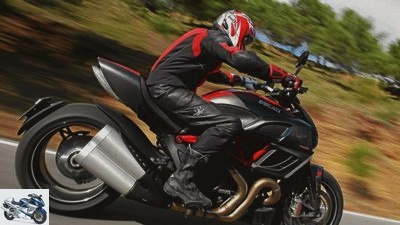
Photo: Ducati
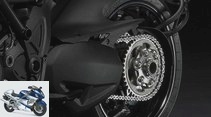
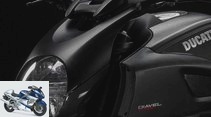
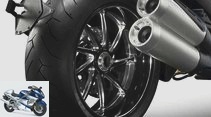
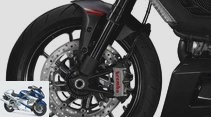
10 photos
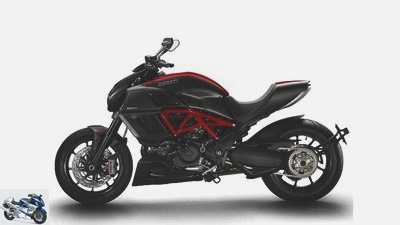
Ducati
1/10
Ducati Diavel Carbon: The Italians officially presented their Power Cruiser at the Eicma. According to Ducati, the Testastretta 11 ° engine should produce 162 hp at 9500 rpm. The torque is specified as 127.5 Nm at 8000 rpm. Displacement: 1198.4 cm³.
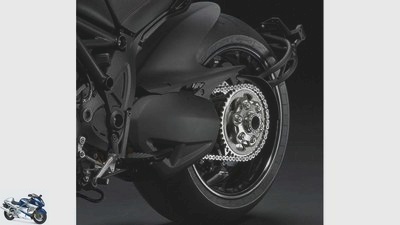
Ducati
2/10
Ducati Diavel
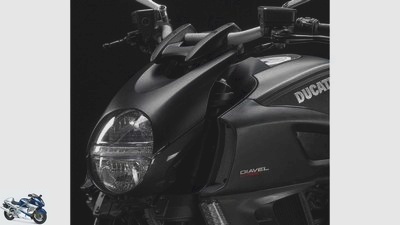
Ducati
3/10
Ducati Diavel
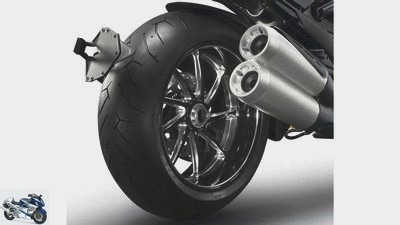
Ducati
4/10
The thick 240 mm slipper was specially developed by Pirelli for the Ducati Diavel.
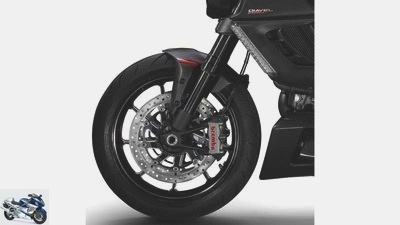
Ducati
5/10
Ducati Diavel: Brembo stoppers and ABS are standard on board.
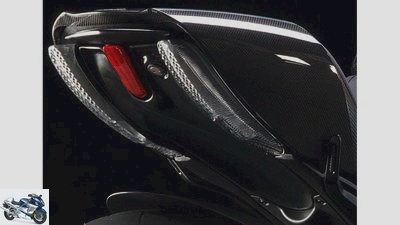
Ducati
6/10
The rear of the Ducati Diavel.
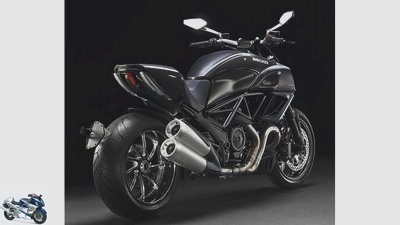
Ducati
7/10
Ducati Diavel Carbon – standard equipment: traction control, ride-by-wire, ABS, keyless-go, LED taillight and indicators and a TFT color display serves as a cockpit display.
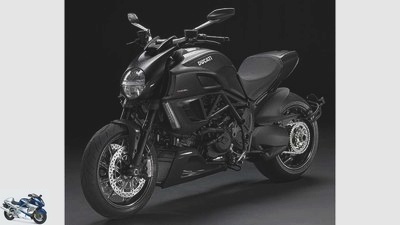
Ducati
8/10
Ducati Diavel Carbon: With a dry weight of 207 kg, the carbon version is around three kilos lighter than the standard version.
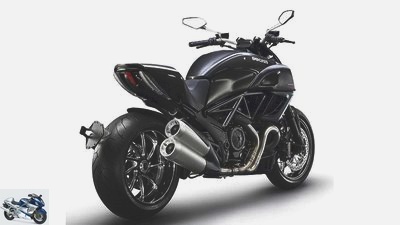
Ducati
9/10
Ducati Diavel Carbon: In the back, the Power Cruiser rolls on a mighty 240 tire.
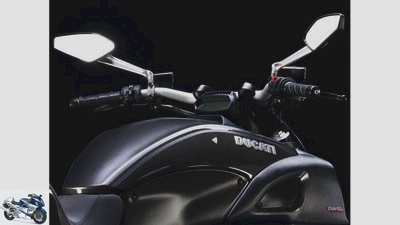
Ducati
10/10
Ducati Diavel
Driving report Ducati Diavel (2011)
Power cruiser: the loot of madness
Dear friends of long wheelbases. Mourn Harley’s V-Rod, pity Yamaha’s Vmax and forget about Suzuki’s M 1800 R – Ducati’s Diavel is here: With her, the Italians have reinvented the wheel. Almost…
Would Harley-Davidson come up with the idea of building a super sports car? I agree! So why, in God’s name, is Ducati getting ready to let a cruiser off the leash? The answer will be given by the motorcycle itself at the presentation in Malaga, Spain. In the evening, under the Andalusian sun, the reds happily hand me a welcome champagne and the next morning proudly the Diavel ignition key. In between we listen to the explanations of the Ducati crew: The wheels are rounder again, the chain is greased, the engine is livelier and the seat is fluffier. Aha. At the same time, the eye scans the new part, illuminated by headlights, moved into the center. Unfamiliar shapes, a completely new type of bike, worshiped almost like a god by the red team. But then why did they name the thing? D.miss iavel (devil)? Project manager Giulio Malagoli explains it like this: At the sight of the prototype, an employee would have shouted in shock: “The purest devil’s roast!” It’s good that the man didn’t faint at the sight – Ducati Koma sounded strange.
Buy complete article
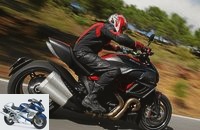
Driving report: Ducati Diavel
Power cruiser: the loot of madness
Ducati
Waiting for scratchy noises.
Think. As soon as the side stand folds up, I casually rock the fully fueled Diavel back and forth between my legs over the aluminum handlebars, I realize that the Reds have not exaggerated: 210 kilograms without operating materials – madness that feels good. Harley’s Rods weigh 60 kilos, Yamaha’s Vmax even two hundredweight more. If anything, then these are the opponents of the Diavel, because this machine is a mixture of dragster, muscle bike and cruiser. But one with predominantly athletic DNA.
Begin. The starter drags the crankshaft around its axis in slow motion. The 1198 cc Testastretta two-cylinder engine, which is derived from the Multistrada and is also known from the super athletes, starts its work a bit jerky. Without the throttle valve body and supplies, it weighs only 63 kilograms. Here we go. That sound, great! Bassy, potent, robust. One would like to take him in. And flood your ear canals with it again before you go to sleep – the somewhat different bedtime sonata.
The first destination is the motorway. To get a feel for how stable the Diavel is in a straight line. Before that, you have to meander slowly flowing car corsos and surf two or three roundabouts … But which film am I in here? A monster with a 1590 millimeter wheelbase, 62 degree steering head angle, 130 millimeter caster, 24 millimeter fork offset and a rear tire that makes most medium-sized car owners envy, dashes through the streets so agile that you seriously think about whether it was in the 25 years ago Adolescent carelessness tried light drugs can suddenly show a long-term effect. There has never been an outwardly bulky-looking motorcycle with 240 mm slippers, but such cooperative steering behavior. You see the winter scars in the asphalt and the truck grooves flowing towards you, instinctively cramping up and expecting someone to knock your back out of the track. But nothing like that happens. There are cruisers and even sport bikes with 200 soles that react much more violently to bumps. The secret? While the competition partly rolls on 18-inch rear wheels with flat contoured tires, the Ducati is equipped with a 17-inch and eight-inch-wide rear rim on which a Pirelli Diablo Corsa II specially developed for the Diavel sits. Its contour is more roof-shaped, more pointed than that of the competition. That makes the Italian devil more agile and reduces the set-up moment. “We developed the motorcycle around the tire,” explained project manager Malagoli. In your mind you can now see the technicians whizzing, the tire on the floor, dragging parts from the Ducati shelf and experimenting. Of course it wasn’t like that. In reality, tests were initially carried out with standard tire sizes, but soon they realized that the Diavel had to be more manageable than the competition. That’s why Pirelli was brought on board.
Ducati
Both radiators of the Diavel are arranged lengthways to the direction of travel, the huge elbows resemble a stainless steel boa,
So you fold the load over the wide aluminum handlebars and reach the driveway to the expressway with a short spurt. Oops! Instead of a threading lane, the Spaniards rely on eight-way signs. Into the anchor. Full delay! And completely stress-free, because ABS is standard on board. Radially bolted Brembo fixed calipers in monobloc construction attack 320 mm brake discs at the front, while a two-piston brake caliper bites into a 265-millimeter disc at the rear. The whole ensemble is conducted by a Bosch ABS of the latest generation. The anchors installed at the front come directly from Ducati’s super sports bikes. On the Diavel, which is immune to involuntary stoppies due to its long wheelbase, they impressively prove what they are capable of. The delay is so brutal, so immense, almost as if it hit an invisible wall. You have to be careful not to fall over, the load stops so quickly. So quickly get off your feet, take a deep breath. Look over the shoulder. Two more cars, then we’re ready to go. Free! Gaaas! The Diavel clicks forward. The engine hammers through the rev range. Harder than a Harley Rod, but actually surprisingly unspectacular. Hmmm. Shifting at 8000 rpm, around 10,000 are possible, the gears engage cleanly, and thanks to the new oil bath clutch, the clutch can be operated without excessive effort. Skeptical scrutinizing look at the two-part display – oh, bad mistake, I’m driving in urban mode!
Embarrassing to move that dragster in pussy-voting. Like the Multistrada, the Diavel also offers a choice of three driving modes: Urban, Touring and Sport. In urban mode, only 100 hp are called up, the traction control regulates early, takes the power back before the slightest slide, and the motor reacts to gas commands like an anti-authoritarian mother to arguments of her children. Good for driving in the rain and riding over gravel roads, but not for fun on grippy asphalt. The touring mode activates the twin’s full 153 hp, responds more directly, and the traction control does not intervene quite as early as in the urban setting. It is possible to switch between the modes while driving. But I want to know and switch to sport mode immediately. That means traction control that intervenes much later plus almost digital implementation of the gas commands.
Other power bikes in the test: BMW S 1000 RR, Kawasaki ZZR 1400 and Yamaha Vmax
Ducati
A men’s bike: hard and merciless.
The devil rolls calmly in third gear, 100 km / h, 5000 tours. Now suddenly open the gas! Oh, a completely different world. What a good 50 hp more make. Suddenly the throttle turns into the trigger of a sharp weapon. And the bench that I smiled at as a hollow – which by the way is quite comfortable – now makes sense. The thrust of the engine is so powerful that it presses you backwards, and I’m happy to be able to support myself with my butt against the acceleration. Anyone who rips open the engine over 5000 rpm wakes up a monster. An acceleration monster. Incredible.
Next attempt, now the sprint from a standing start. Aim at the parking lot, accelerate in sport mode. What comes next can only be compared to a medieval rack. No slip, the Pirelli meshes with the asphalt. Unfortunately. The arms grow long, an invisible fist pushes my head back – the box wants to leave without me. Here in Spain on the motorway. I won’t allow that. Hands cramp, the neck is pulled. Later that evening, Ducati press boss Francesco Rapisarda will laugh and pat me on the back. He only names one value, but it says it all: 2.6 seconds. From zero to one hundred. Rounded up. Because actually it would be 2.58 seconds. But as an Italian one is generous. During test drives in Nardo’s high-speed oval, the Reds slipped the Diavel into their test driver Alessandro Valia, an ex-Superbike pilot, and said: “Get in! Anything goes! ”With the original translation, Valia allegedly punched those 2.58 seconds into the asphalt. With a 41 instead of a 43 chain sprocket, it should have been only 2.4 seconds. For comparison: The previous best value measured by MOTORRAD is 2.7 seconds from zero to one hundred, with Yamaha Vmax.
Now I feel as if the Testastretta is hammering the blood through my veins too. This engine is amazing. It needs 9500 tours for its 153 hp. And 8000 rpm to deliver its maximum torque of 122 Newton meters. The overall gear ratio for the Diavel is shorter than for the super sports bikes.
And through a huge airbox that is under the tank, he breathes more forcefully than in the Multistrada. With a 58 millimeter manifold, the twin chases out the burned gases just as effectively. A valve overlap designed for draft and power from the much-cited cellar contributes to make this devil appear adorable, like his low weight.
Ducati
The large, two-part TFT-LCD display.
An hour later somewhere in the Spanish hinterland. The jungle of curves rolls out in front of the wheels. Now it’s time to slow down gently. At around 60 km / h I carefully pierce the first bend. Feel me slowly further down the valley, radius by radius. Get more and more daring, wait for the scratching that is common with such hip flasks. Wait and wait … nothing. The Diavel should have 41 degrees of lean angle. That’s enough for the Eifel and the Alps. And in northern Germany you only need 23 degrees, harhar. She doesn’t sit down until very late and scratches delicate autographs in the tar with her footrests. The Diavel is stable even in wide, fast corners.
The fully adjustable chassis does its part. It’s tightly tuned, but not comfort-free. The lattice frame made of steel tubes is stiff and light, the self-supporting frame rear consists of plastic elements. What more do you want?
The evening sun licks over the Diavel’s muscular body. The new Italian toy for adults provided clear answers to the question asked at the beginning: This Ducati is lighter, more agile, sportier and stronger than all known cruisers and muscle bikes. It has the potential to duel with most naked bikes on country roads and steals the show from many an expensive custom bike. You don’t even have to sell your soul for the Diavel. 16,995 euros do it too. If that’s not devilishly tempting…
Click here for the video of the Diavel presentation:
Technical specifications
Ducati
The Ducati Diavel Carbon with forged wheels (19,990 euros).
Engine:
Water-cooled two-cylinder four-stroke 90-degree V-engine, two overhead, toothed belt-driven camshafts, four valves per cylinder, rocker arm and rocker arm, operated desmodromically, wet sump lubrication, injection Ø 56 mm, 480 W alternator, 12 V battery , 10 Ah, hydraul. Actuated multi-disc oil bath clutch (anti-hopping), six-speed gearbox, chain, secondary ratio 43:15.
Bore x stroke 106.0 x 67.9 mm
Displacement 1198 cc
rated capacity 112.8 kW (153 hp) at 9500 rpm
Max. Torque 122 Nm at 8000 rpm
landing gear:
Steel tubular frame, upside-down fork, Ø 50 mm, adjustable spring base, rebound and compression damping, single-sided swing arm made of aluminum, central spring strut with lever system, adjustable spring base, rebound and compression damping, double disc brake at the front, Ø 320 mm, four-piston fixed calipers, disc brake rear, Ø 265 mm, two-piston fixed caliper, ABS.
Spoked wheels with aluminum rims 3.50 x 17; 8.00 x 17
Tires 120/70 ZR 17; 240/45 ZR 17
Mass and weight:
Wheelbase 1590 mm, steering head angle 62.0 degrees, caster 130 mm, spring travel f / h 120/120 mm, dry weight 210 kg, tank capacity 17 liters.
guarantee two years
colour Red / black price 16690 euros
Additional costs 305 euros
Related articles
-
Ducati Diavel Carbon in the driving report
Ducati 21st photos Ducati 1/21 The seating position is somewhere between cruiser, dragster and muscle bike. TSR 2/21 Shortened, now diagonally cut…
-
Gargolov 10 photos Ducati 1/10 Ducati Diavel Carbon: The Italians officially presented their Power Cruiser at the Eicma. According to Ducati, the…
-
Premiere: Ducati Diavel driving report
Ducati Premiere: Ducati Diavel The power cruiser from Ducati in the driving report Content of Ducati enters the power cruiser market with the Diavel….
-
New motorcycle products: Ducati Diavel (with video)
Ducati 10 photos Ducati 1/10 Ducati Diavel Carbon: The Italians officially presented their Power Cruiser at the Eicma. According to Ducati, the…
-
Ducati Diavel 1260 S in the driving report: Power bike goes devilish
14th photos to the video Ducati 1/14 How is the new Ducati Diavel 1260 S doing on the first ride in Spain? Ducati 2/14 In 2011 the very first Diavel was…
-
Ducati Supersport-S in the PS driving report
Ducati 14th photos Ducati 1/14 A very sporty sports tourer or a very touristic super sportsman? Right in between , Project engineer Giuseppe Caprara…
-
Ducati Panigale R in the driving report
Ducati 20th photos Ducati 1/20 Technically, in terms of weight and price, the Panigale R lies between the Superleggera and the 1299 Panigale S.. Ducati…
-
Ducati Multistrada 1200 Enduro in the driving report
Ducati 25th photos Ducati 1/25 First, let’s see what the Duc has to offer: Thick comfort seats, large suitcases (special equipment), high windshield and…
-
Ducati Monster 1200 S in the PS driving report
Ducati 18th photos Ducati 1/18 Ducati Monster 1200 S.. Ducati 2/18 Ducati Monster 1200 S.. Ducati 3/18 Ducati Monster 1200 S.. Ducati 4/18 Ducati Monster…
-
Ducati Hypermotard 939 SP in the PS driving report
Ducati 27 photos Ducati 1/27 Ducati Hypermotard 939. Ducati 2/27 An oil cooler was implanted in the revised engine, which can be seen on the front of the…